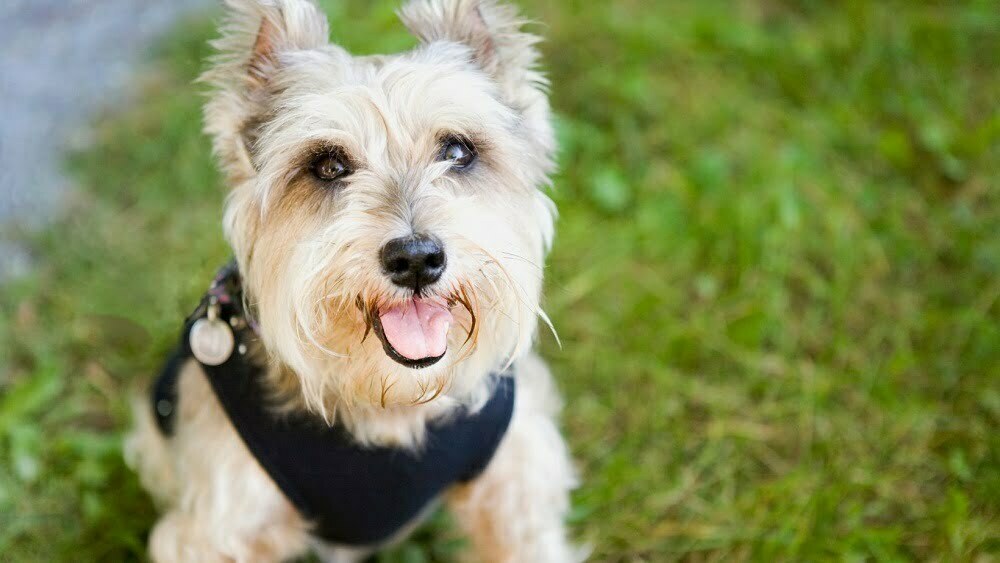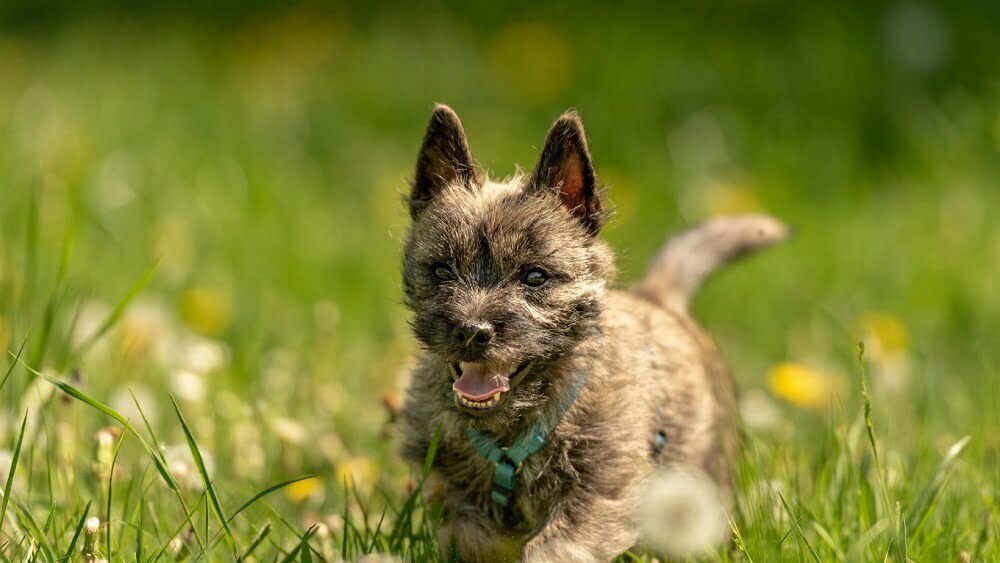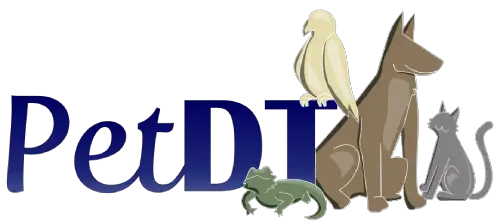Life in the Hebrides and Highlands of Scotland makes the natives independent and tough, and the Cairn Terrier, the dog that was bred by the farmers in islands and highlands to chase down and control the rodent population follows that blueprint to the letter.
It’s the little dog with the heart of a giant, that isn’t afraid to express its opinion and make its presence known, no matter where it finds itself.
Intelligent, commanding, and with a single-minded determination to defy any and all authority with a good-natured, devil may care attitude, the Cairn Terrier will be sitting on your knee one minute and testing the boundaries of your patience to their absolute limit the next.
They are a wonderful contradiction, and it’s that strange mishmash of a lap dog and working terrier that they effortlessly exude that has endeared them to families the world over

A little dog with a huge personality, the Cairn Terrier is bursting with confidence, bluster, and calm, and has a genuine affinity and affection for the members of its immediate family.
But trying to find out everything that you need to know about this diminutive dynamo can be an exercise in futility that would drive Job to distraction, That’s why we’ve done all of the hard work for you and compiled this one-stop list of everything that you’ll ever need to know about a shaggy-haired hunter from the Isle of Skye.
Cairn Terrier Key Facts
It’s easy to fall for a Cairn Terrier, as their endless charm and energetic charisma make them an ideal companion for anyone who shares their boundless enthusiasm for life.
But if you are considering whether or not they’re the right dog for your household and if they’ll fit in with your family or not, before we get into the minutia and explore everything that you’ll need to know about the breed, we’ll take a cursory, quick look at the basics so you’ll have a better understanding of what looking after a Cairn involves.
Caring for a Cairn Terrier is a lifelong commitment, so we’ll explain just how much attention, and time you’ll need to devote to looking after one to ensure that your hairy little pal from the Highlands lives a long, healthy, and happy life.
And, so no stone is left unturned, we’ll also pull back the financial curtain and give you a quick glimpse at the extra-economic toll that adding a Cairn Terrier to your household will have on your monthly bank balance.
Average Lifespan
Remember what we said about nature and the natives of the Highlands and how the latter made them hardy, robust, and strong? Well, that explains why Cairns tend to live so long, and you can expect your new best friend to be part of your life for anywhere between fourteen and seventeen years.
Minimum Exercise (per day)
They may be small, but they have a seemingly endless supply of energy, so you’ll need to exercise and play with your Cairn Terrier for at least an hour a day. One thirty-minute outing in the morning and another in the evening.
Coat Length:
Cairn Terriers are shaggy, medium to long-haired dogs bred to deal with Scotland’s cold, wet and windy weather.
Minimum Cost Per Month
Size isn’t everything, but it does have a discernible impact on the cost of raising a Cairn. Even with the cost of pet insurance factored into the economic equation, it shouldn’t cost you more than ninety dollars a month.
Appearance
Equipped with a weather-resistant fur coat that’s rough and ready on the outside, but hides a soft undercoat, these wide-headed, pointy-eared Terriers have short legs, a tail that works overtime in the wagging department, and can be silver, black, cream, gray, red or brindle in color.
But one of the best-kept secrets of the breed is that they can, and sometimes do change color throughout their lives, so a silver Terrier puppy could be a black adult, before returning to the silver of their youth in their dotage.
Size
Cairn Terriers are small dogs, and while they’re dainty enough to dwell happily on your lap, they’re still more than big enough to tear their own path through the world outside their door.
Average Height
The average Cairn Terrier stands between nine and ten inches tall at the shoulder.
Average Weight
And being little dogs, they don’t really weigh a lot and you should expect your Cairn to be between twelve and fourteen pounds.
Temperament
Described as curious, inquisitive, and always eager to explore their surroundings and learn as much they can about the world, these playful little dogs love to spend time with their families, and are affectionate, energetic, and always happy.
Apartment Living
Despite their always on the go, high energy levels, as long as a Cairn Terrier is properly exercised, played with, and doesn’t succumb to boredom, they can (and often do) live in an apartment.
Good For Novice Owners
They’re perfect dogs for first-time owners, as long as you’re prepared to spend time with, and exercise them. And as long as you’re prepared to have your authority regularly challenged in a light-hearted and good-natured fashion, then you’ll get on famously, and fabulously with a Cairn Terrier, whether you have any previous experience with dogs or not.
Sensitivity Level
Cairns are sensitive little dogs and will respond according to how well they’re treated. If they’re trained to follow your lead with a positive, reward-based system, they’ll be a happy, affectionate dog, but if they’re punished or overly chastised, it can have a negative effect on their personality and how they interact with you and the world at large.
Tolerates Being Alone
Unfortunately, as they’re affectionate, social little dogs, they are prone to separation anxiety so you’ll have to teach them that it doesn’t matter how long you leave for, you’ll always come back. A Cairn who learns this early enough can be left alone successfully, but if they aren’t taught this lesson properly, their separation anxiety can manifest as destructive and even loud antisocial behavior.
Tolerates Cold Weather
They were bred in the Hebrides and the Highlands, and their outer coat is weather and waterproof (mostly), so Cairns can cope quite well with cold weather, as long as it doesn’t get TOO cold.
Tolerates Hot Weather
The weatherproof coat that protects the Cairn Terrier from the cold, also makes sure that it can cope with warmer weather just as well as the cold. It’s a resilient little Terrier that can function equally well in any climate.
Affectionate With Family
Cairn Terriers are affectionate with their family members, and while they enjoy being cuddled and spending some time on your lap, they’ll only usually do so on their own terms. They’re friendly little dogs, but sometimes they’d rather play than have their belly scratched.
Kid-Friendly
They love children, and love being around children as children have something in common with Cairn Terriers, They both love to play and make noise, which makes them ideally suited to one another.
Dog Friendly
As long as they’re properly socialized from an early age, the Cairn Terrier’s good nature means that they’ll usually get on well with other dogs, and in most cases can also happily live with cats too.
Friendly Toward Strangers
While they tend to be friendly with people, Cairn Terriers can be standoffish with strangers and appear aloof and disinterested until they’re introduced to them properly. They tend to prefer the company of people they know and already trust.
Health & Grooming

Hardy, resilient little dogs, Cairn Terriers are nonetheless susceptible to some breed-specific health issues and conditions that we’ll look at a little more closely further on. Before we do, though, we’ll have a look at some of the things you’ll need to know about your Cairn Terrier to properly care for him.
Shedding
Even though they have rough, rugged, and wiry, longish outer coats, Cairn Terriers shed very little and are classed as a hypoallergenic breed, making them dogs for all seasons all people, regardless of allergies.
Drooling
And if you are not exactly a fan of dog drool, the news just keeps getting better and better, as Cairn Terriers don’t drool. Well, apart from at meal times when all dogs drool in anticipation of their dinner, but apart from that, they don’t drool and so you won’t have to worry about dog slobber and saliva with Cairn Terriers, because they make sure that it stays where it should. Inside their mouths.
Grooming
Even though they don’t shed much, Cairn Terriers need to be professionally groomed in order to maintain their outer coats. Traditional grooming methods such as clipping and cutting with scissors can ruin the integrity of their outer coat, which needs to be preserved by hand stripping.
And the bad news is, if you do it wrong or don’t know what you’re doing, you could hurt the dog, and a hurt dog is more likely to sulk, or even in some extreme cases, attempt to retaliate. So leave the grooming up to the professionals, who know what they’re doing.
General Health
The breed is generally healthy and doesn’t suffer any problems that could slow it down or could potentially make its life miserable.
Common Health Problems
- There are however a number of common health problems that Cairn Terriers are susceptible to, and these include Craniomandibular Osteopathy (which is a malformation of the skull and jaw that can lead to lifelong eating problems if it isn’t treated properly), Krabbe’s disease (a neurological condition that is incurable), Cryptorchidism (in which one or both testicles fail to descend and have to be removed surgically in order to prevent them becoming cancerous), Legg-Calve-Perthes Disease (that restricts the blood supply to the femur and leads to its eventual disintegration, but can be addressed and corrected surgically) and secondary glaucoma (which can cause premature blindness).
- It is important to note that just because your Cairn could suffer from any of these conditions, it DOESN’T mean that he will. Potential inherited health and genetic issues are also the reason why we always recommend pet insurance as it can drastically reduce any possible veterinary bills.
Potential For Weight Gain
And the hits just keep on coming, as Cairn Terriers are prone to obesity, and any weight gain can make potential joint and cardiac problems even worse, so you’ll need to constantly monitor your Cairn’s diet to make sure that it doesn’t pile on any unwanted pounds.
Trainability
Every dog benefits from a rigid system of training that’s flexible enough to let them learn what you expect of them, but at the same time doesn’t reward deviation or bad behavior. Cairn Terriers are no different and need to be socialized and trained from an early age.
Easy To Train
We know what you’re thinking, as it’s a working dog a Cairn Terrier should be easy to train, and while that’s true, as the Cairn has a stubborn, independent streak, it can take time and patience to train the dog properly.
Boundaries need to be established early as the Cairn will push against them at any and every opportunity, so you’ll need to stand your ground and be firm with the dog. Reward good behavior and compliance and ignore bad behavior and your Cairn will soon start to come around to your way of thinking.
Intelligence
Like all working dogs, Cairn Terriers are incredibly intelligent and can learn quickly and easily adapt to new situations, but the trick is getting them to do what you want them to do when you need them to do it.
Which is why it’s important to start training your Cairn with a positive, reward-based system as soon as it becomes part of your family.
Potential To Bite
While they’re unlikely to bite people, being hunters, Cairn Terriers have a prey drive and an aggressive streak, which could make them likely to bite other dogs. If they’re socialized with other dogs and animals from an early age, this aggressive streak can be curbed and easily controlled., so it’s vital to ensure that your dog is properly trained and socialized.
Tendency To Bark Or Howl
They’re terriers, which means that they can be incredibly noisy, and once they start barking it’s difficult to get them to stop. If your Cairn is an excessive barker, it’s worth monitoring their behavior to see what triggers their barking and figuring out a way to control or mediate the triggers and your dog’s reaction to them.
History
Even though it was only recognized as a breed by the Kennel Club just over a century ago in nineteen twelve, the Cairn Terrier is at least two hundred years older than that.
Originally bred in the Isle Of Sky and in the Highlands of Scotland by farmers who wanted an efficient way to control their rodent problems, the Cairn Terrier was named after the Cairns that it used to chase rats around.
Originally part of a designation that included West Highland and Scotch Terriers, it was only when the breed changed its name from the Skye Terrier to the Cairn Terrier that the Kennel Club officially recognized it as being separate from the other aforementioned Terriers.
A year after it was officially recognized by the Kennel Club, the first Cairn Terriers were officially taken to America, and four years later, the breed was also recognized by the American Kennel Club.
Costs
You might want to sit down and prepare yourself because Cairn Terrier puppies aren’t exactly cheap. Depending on whether or not the puppies are registered with the AKC (American Kennel Club), the bloodline of the parents, and the breeder’s reputation, a Cairn Terrier can cost anywhere between twelve hundred and five thousand dollars.
There is, however, a cheaper and more ethical way to find your dream Cairn Terrier, and that involves calling your local shelter and rescue.
Sometimes even Cairn Terriers are handed over to shelters and rescues, so give them a call and who knows, your new best friend could be there waiting for you to pick him up.
And, as we always say, it won’t just be the rescue dog who’ll be eternally grateful that you gave him a home, your bank balance will be as well, because it’s far more adorable to adopt than it is to shop.
Cairn Terrier Fun Facts
- The second most famous dog in cinematic history, Toto, who accompanied Dorothy to the land of Oz in The Wizard of Oz was a Cairn Terrier named Terry, who had been signed over to a movie trainer called Carl Spitz.
- A Cairn is a stone mound that was first built during the neolithic period as a tomb marker, and so the little dog that was bred to chase and catch rodents was actually named after a gravestone that was created by cavemen.
- Their front paws are bigger than their back paws, an evolutionary trait that’s leftover from the breed being bred to chase after rats, who used to try and escape from the dogs by hiding in holes in the ground, It did them no good, as the Cairn’s larger front feet meant that it was an excellent digger.
- It still is, so if you value your yard, keep an eye on your Cairn as they might just dig it up while you’re not looking.
